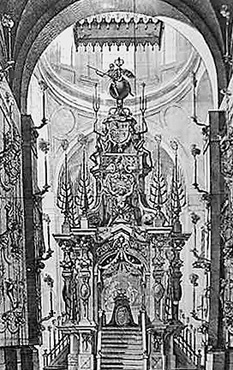 |
| Catafalque of Maria Luisa de Borbon, Church of La Encarnación, Madrid, 1689 |
"Spanish Catafalques of the Sixteenth and Seventeenth Centuries"
In the sixteenth century it became common to commemorate a royal death in the Catholic countries of Europe by erecting large, multi-tiered structures designed to display a mock coffin, or repraesentatio, often with an effigy of the deceased. These catafalques were built at royal request in each of the realm's major cities, usually in the crossing of the church where they were the focal point of elaborate obsequies involving prayers, orations, a requiem mass, and absolution rites. Although monumental, catafalques were temporary structures. They were dismantled after the memorial services, but contemporary engravings and detailed descriptions contained in commemorative funeral books provide a record of their appearance.
The architectural design and the ornamentation of the catafalque together created a complex, sophisticated symbol of the importance of the deceased. Heavily decorated with various combinations of allegorical figures or scenes, religious figures, antique motifs, coats of arms, emblems, hieroglyphic poems, and other symbols, catafalques glorified the deeds, patronage, and actions of the deceased, and demonstrated his or her worthiness for the kingdom of heaven. In Spain, catafalques also glorified Spain and her dominions, the Hapsburg monarchy, and the Catholic Church; if not by direct reference, then by erudite allusion and allegory. Spanish catafalques also reflected the special interests of their patrons, whether they be the local authorities or the Crown.
As a revival of antique forms, customs, and iconography; as devout monuments signifying the eternal salvation of the deceased; and as official propaganda, catafalques are valuable social, religious, and political documents for the sixteenth and seventeenth centuries. This is particularly true for Spain where catafalques differed significantly in architectural form, decorative ornamentation, and symbolic content from those erected in other countries. Spanish catafalques exhibited a unique synthesis of pagan philosophy, Hapsburg politics, and Catholic theology.
This dissertation investigates the origins, forms, and iconography of Spanish catafalques and presents a catalogue raisonné of all known Spanish catafalques of the period. |



